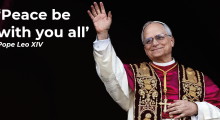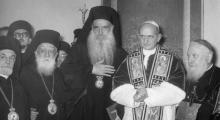Issued by the Catholic Center for Studies and Media - Jordan. Editor-in-chief Fr. Rif'at Bader - موقع أبونا abouna.org

A path offered to every human being—a journey inward, a reckoning of conscience, pausing on Christ’s sufferings on the way to Calvary. In his Via Crucis meditations, Pope Francis shows that the Way of the Cross is indeed the descent Jesus undertook “toward this world that God loves” (Station II). It is also “a response, an acceptance of responsibility” by Christ. He who, “nailed to the Cross,” intercedes, placing Himself “between conflicting parties” (Station XI), and carries them to God, for His “cross tears down walls, cancels debts, quashes judgments, establishes reconciliation.” Jesus, “the true Jubilee,” stripped of His garments and revealed even “to those who watch Him die,” looks upon them “as beloved ones entrusted by the Father,” showing His desire to save “all of us, each and every one” (Station X).
God’s economy
Pope Francis invites us to break free from our own schemes and to understand “God’s economy”, which “does not kill, discard or crush. It is lowly, faithful to the earth”—and to follow the path of Jesus, that of “the Beatitudes,” which “It does not crush, but cultivates, repairs and protects.” (Station III). Yet it is the “divine economy” (Station VII)—so unlike today’s economies “of calculation and algorithms, of cold logic and implacable interests”—on which Francis dwells. For humanity, Christ accepted the cross, and its weight speaks of the breath of the Spirit, “‘who is Lord and gives life” (Station II). We, by contrast, “run out of breath from avoiding responsibility.” But, the Pope urges, “is to stop running away and to remain in the company of those you have given us, in the situations where you have placed us”; only then do we cease “to be prisoners” of ourselves. What truly burdens us are “selfishness” and “indifference.”
The prayer of people on the move
In his introduction to the fourteen Stations, Francis writes that in Jesus’ steps toward Golgotha “our exodus to a new land” is reenacted, for Christ “came to change the world,” and we too must “change direction, see the goodness of His traces.” Thus, “The Stations of the Cross is the prayer of people on the move. It disrupts our usual routine.” It is a costly way in “this world that calculates everything,” where “gratuitousness comes at a dear price.” Yet “in the gift,” the Pope observes, “everything blossoms anew: a city split into factions and torn by conflict can move towards reconciliation; an arid piety can rediscover the freshness of God’s promises; and a heart of stone can turn into a heart of flesh.”
Human freedom
Jesus’ sentence of death prompts reflection on “dramatic interplay of our individual freedoms” (Station I). From the irrevocable trust with which God places Himself “in our hands,” bringing a “holy restlessness,” marvels can spring forth: “freeing the unjustly accused, discerning the complexities of situations, countering judgments that kill.” Yet we remain “prisoners” of the roles we cling to, afraid of the inconvenience of a change in our life’s direction. Often we let slip the possibility of the Way of the Cross. Christ, “silently before us in every sister and brother exposed to judgment and prejudice,” challenges us—but a thousand reasons (“religious arguments, legal quibbles,” and “the so‑called common sense that avoids involvement in others’ destinies”) drag us to the side of Herod, the priests, Pilate, and the crowd. Still, Jesus does not wash His hands of it; He loves “in silence.” In Station XI, nail‑ridden, He “shows us that in every circumstance there is a choice to be made”—the “amazing reality of our freedom”—as He attends both criminals, letting one’s insults pass and welcoming the other’s plea, even interceding for those who crucify Him: “Father, forgive them; for they do not know what they are doing.”
Falling and rising
At the Third Station, Jesus “falls the first time,” teaching that “the Way of the Cross is traced close to the earth: the mighty withdraw from it, yearning for heaven. Yet heaven hangs low, and we can find it even in our falls.” At His second fall (Station VII), Christ shows us “fall and rise again; fall and rise again,” the human adventure of sin and conversion. “We hesitate, stray, become lost,” yet we also experience joy—“the joy of new beginnings, the joy of rebirth.” Humans are “handcrafted”—unique mixtures of grace and responsibility. Jesus, made “one of us,” did not fear to stumble. We, however, often hide our falls, rejecting the path Christ chose. God’s economy, in which “ninety‑nine matter more than one,” is inhumane: today’s world is built on such logic “of calculation and algorithms, of cold logic and implacable interests.” The “divine economy,” by contrast, “is different.” Turning to Christ, who falls and rises, is “a change of course and a change of pace—a conversion that restores joy and brings us home.”
Like the Cyreneans
In Simon of Cyrene (Station V), returning from the fields, “they laid the cross on him,” illustrating how we can stumble upon God unexpectedly. Though Simon did not ask for the cross, he bore it. Christ’s yoke is “easy, and His burden is light,” and He loves involving us in His work that “which ploughs the earth so that it may be sown anew.” We need that surprising lightness. Without God, toil is in vain; “On the way of the cross, the new Jerusalem is rising.”
Women along the road to Calvary
Stations IV, VI, and VIII highlight women: Mary, Veronica, and the daughters of Jerusalem. Mary’s discipleship is “not a sacrifice but a continuous discovery.” She, “the first disciple,” shows that “In God, words are deeds, promises are realities.” Veronica’s veil bears Christ’s face—the proof of “His decision to love us to the last breath, and even beyond,” for “love is as strong as death.” And the daughters of Jerusalem, moved to weep, are urged to weep “for themselves and their children,” for our wounded coexistence, our broken world calls “for tears that are heartfelt and not merely perfunctory”.
Jesus is among those who hope
At Station XIII, Joseph of Arimathea, “a good and righteous man … waiting expectantly for the kingdom of God,” takes Jesus’ body. Christ is “in the hands of someone who continues to hope, one of those who refuse to think that injustice always prevails,” granting “great responsibilities,” emboldening us. Finally, at Station XIV, the Sabbath silence of Holy Saturday: “Teach us how to do nothing at those times when it is asked of us only to wait. Teach us sensitivity to the seasons of the earth.” Jesus, “laid in the tomb,” shares in our human condition, descending into the depths we fear, teaching rest, anticipation, and preparing all creation for resurrection peace.
Concluding Prayer
“‘Laudato sì, mi’ Signore’—‘Praise be to you, my Lord.’ In Saint Francis of Assisi’s canticle, our common home is a sister who cries out because of the harm we have inflicted on her. ‘Fratelli tutti’—‘Brothers and sisters all,’ the Pope writes, calling us to be marked by the flavour of the Gospel, ‘He loved us,’ wrote Saint Paul, ‘to make us realise that nothing can ever ‘separate us’ from that love.’
We have walked the Stations of the Cross. We have turned towards the love from which nothing can ever separate us. Now, as the King sleeps and a great silence descends upon all the earth, let us pray, in the words of Saint Francis, for the gift of heartfelt conversion:
“Most High and glorious God, Cast your light into the darkness of my heart. Grant me right faith, firm hope, perfect charity, and profound humility. Grant me, Lord, wisdom and understanding, so that I may do your true and holy will. Amen.”






